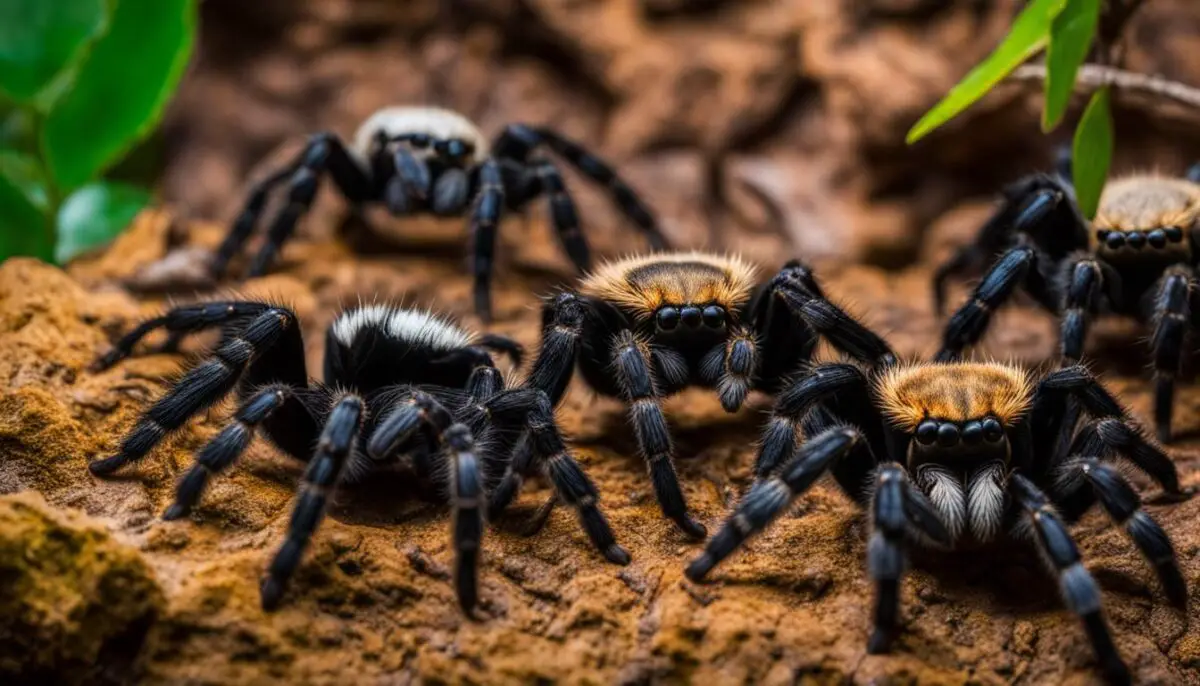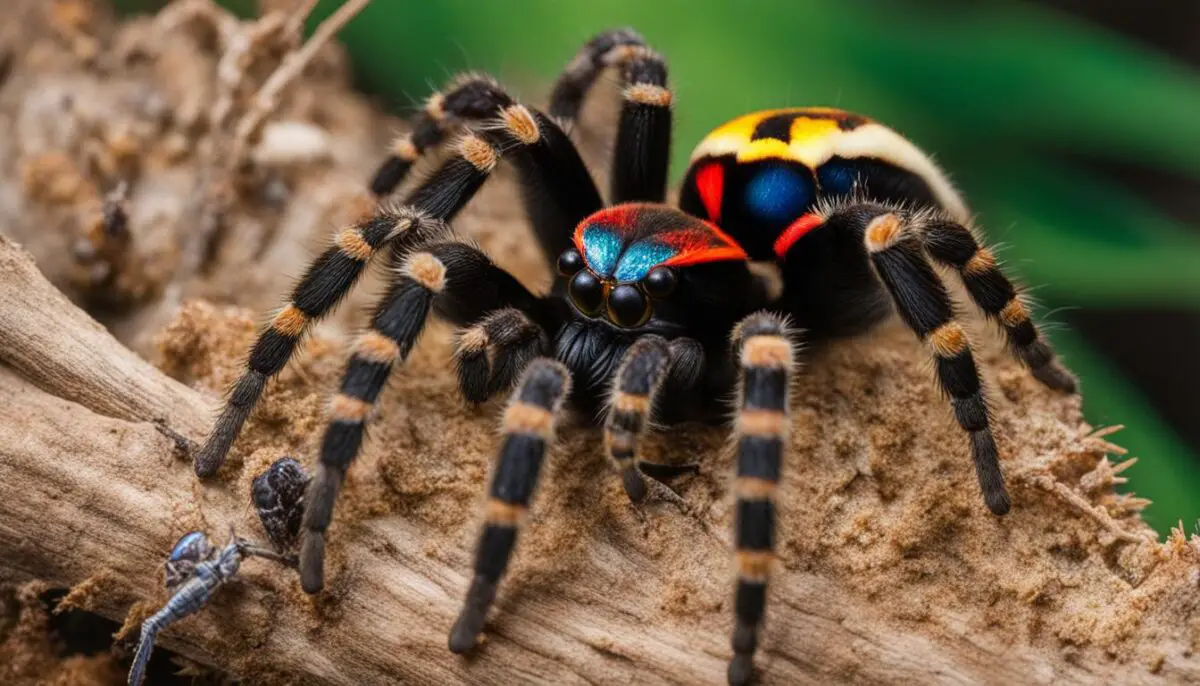Tarantulas, with their intimidating appearance and reputation, have long fascinated and sparked curiosity among both arachnid enthusiasts and the general public. While most tarantula bites are harmless to humans, there are a few species that can pose a potential threat. In this article, we will delve into the world of tarantulas and explore which species are considered dangerous, as well as debunk some common misconceptions about their venom and bites.
Key Takeaways:
- Not all tarantulas are dangerous to humans.
- There are a few species that have venom potent enough to potentially cause severe allergic reactions or health complications in certain individuals.
- The Brazilian Wandering Spider, Indian Ornamental, and Venezuelan Suntiger are tarantula species that should be avoided.
- If bitten by a tarantula, it is important to seek medical attention, especially if experiencing severe symptoms.
- Overall, tarantulas are fascinating creatures, but they pose little threat to human life.
Which Tarantulas Can Kill You
Understanding Tarantula Venom
Tarantulas produce venom as a defense mechanism and for subduing their prey. The potency of their venom can vary between species, with some tarantulas having venom that can cause pain, swelling, and other mild symptoms in humans. However, there are no documented cases of tarantula bites causing serious harm or fatalities to humans. which tarantulas can kill you
Tarantula venom is primarily designed to immobilize and break down their prey, which is typically insects, small vertebrates, and other arthropods. The venom contains a combination of proteins and enzymes that help tarantulas digest their prey. These proteins and enzymes can also trigger a response in humans when bitten, leading to localized symptoms such as redness, itching, and mild pain. dangerous tarantulas
It’s important to note that tarantulas generally only bite as a last resort when they feel threatened or provoked. They prefer to use their venom for hunting, not defensive purposes. If you come across a tarantula in the wild or keep one as a pet, it’s best to avoid disturbing or handling them to minimize the risk of a bite. deadly tarantulas
| Tarantula Venom | Symptoms |
|---|---|
| Causes pain | Mild pain at the bite site |
| Contains proteins and enzymes | Redness and swelling |
| Used for subduing prey | Itching and mild discomfort |
While it’s important to treat any tarantula bite with basic first aid, such as cleaning the wound and applying a cold compress, severe symptoms are extremely rare. If you experience difficulty breathing, chest pain, or any severe allergic reactions after being bitten by a tarantula, it is essential to seek immediate medical help. deadly spider species
Dangerous Tarantula Species
While tarantula bites are generally not life-threatening, there are a few species that have venom potent enough to potentially cause severe allergic reactions or health complications in certain individuals. It is important to exercise caution and seek medical attention if bitten by one of these species.
Species
| Tarantula Species | Scientific Name | Venom Potency |
|---|---|---|
| Brazilian Wandering Spider | Phoneutria spp. | High |
| Indian Ornamental | Poecilotheria spp. | Moderate to High |
| Venezuelan Suntiger | Psalmopoeus irminia | High |
These species include the Brazilian Wandering Spider (Phoneutria spp.), the Indian Ornamental (Poecilotheria spp.), and the Venezuelan Suntiger (Psalmopoeus irminia). These tarantulas have venom that can potentially cause severe reactions in humans, such as intense pain, muscle cramps, and difficulties in breathing. It is crucial to be aware of these species and take necessary precautions to avoid bites. tarantula bite symptoms
If bitten by any of these dangerous tarantula species, it is important to seek immediate medical attention. Medical professionals can provide appropriate treatment and monitor for any complications or allergic reactions. If possible, try to capture the tarantula for identification purposes, but do not put yourself at risk in the process. lethal tarantula species
Tarantulas to Avoid
While the vast majority of tarantulas are harmless to humans, there are a few species that should be avoided due to their potentially dangerous bites. These species include the Brazilian Wandering Spider, the Indian Ornamental, and the Venezuelan Suntiger. It is important to educate oneself on the specific characteristics of these species to avoid any harmful encounters. dangerous spiders
| Tarantula Species | Danger Level | Characteristics |
|---|---|---|
| Brazilian Wandering Spider | High | Fast-moving and aggressive, known for its potent neurotoxic venom |
| Indian Ornamental | Moderate | Beautiful but unpredictable, with venom that can cause severe pain and swelling |
| Venezuelan Suntiger | Moderate | Colorful and defensive, can deliver a painful bite with mild venom effects |
These tarantula species are best left to experienced keepers and not recommended for beginners or individuals without proper knowledge of tarantula care. Their venom can have varying effects on humans, ranging from intense pain and swelling to severe allergic reactions. It is crucial to exercise caution and follow safety guidelines when interacting with tarantulas.
Remember, tarantulas are generally docile and non-aggressive creatures. However, it is always better to err on the side of caution and avoid handling or provoking any tarantula species, especially those known to have potentially dangerous bites. By respecting their natural behaviors and habitats, we can appreciate these fascinating creatures without putting ourselves at unnecessary risk. poisonous spider bites
What to Do if Bitten by a Tarantula
In the rare event of being bitten by a tarantula, it is important to remain calm and take the necessary steps to ensure your safety and well-being. While tarantula bites are generally not life-threatening, it is still essential to seek medical attention if any severe symptoms occur. Mild symptoms of a tarantula bite may include pain, redness, and swelling at the bite site, similar to a bee or wasp sting. If you experience these mild symptoms, you can follow these steps to alleviate discomfort:
- Clean the bite area with mild soap and water.
- Apply a cold compress or ice pack wrapped in a cloth to help reduce swelling.
- Take an over-the-counter pain reliever, such as ibuprofen or acetaminophen, to alleviate any pain or discomfort.
- Avoid scratching or irritating the bite area to prevent infection.
If you experience more severe symptoms after a tarantula bite, it is crucial to seek immediate medical help. These severe symptoms may include difficulty breathing, chest pain, or severe allergic reactions like swelling of the face, throat, or tongue. In such cases, call emergency services or go to the nearest emergency room for prompt medical attention.
It is important to note that tarantula bites are rare, and most people can safely handle or observe tarantulas without the risk of getting bitten. Tarantulas are generally docile creatures that only bite as a last resort when they feel threatened. By exercising caution and respecting their space, you can minimize the risk of encountering any harmful situations.
Remember, if you are bitten by a tarantula, keeping a calm and level-headed approach is key. Seek medical attention if necessary, and adhere to the steps mentioned earlier to alleviate any mild symptoms. By being informed and taking the necessary precautions, you can enjoy a safe and fascinating experience with these amazing arachnids.
Tarantula Lifespan and Behavior
Tarantulas, fascinating creatures known for their unique characteristics, have varying lifespans depending on their species and gender. Female tarantulas typically live longer than their male counterparts, with lifespans ranging from 7 to 30 years. On the other hand, male tarantulas have shorter lifespans, typically living only a few years. Understanding tarantula lifespan is crucial for tarantula enthusiasts and those considering keeping them as pets.
Tarantulas spend most of their time in their burrows, coming out mainly at night in search of food and mates. They are relatively docile creatures unless provoked, and their behaviors can vary between species. Some tarantulas are more active and prone to exploring their surroundings, while others are more reclusive and prefer to stay in one place. By studying their behavior, researchers and enthusiasts can gain valuable insights into the world of these intriguing arachnids.
Additionally, tarantulas undergo molting as they grow larger and reach maturity. Molting is a process where tarantulas shed their old exoskeleton, allowing for growth and development. This process can occur several times throughout a tarantula’s life, with younger individuals molting more frequently than older ones. It is during molting that tarantulas are most vulnerable and require extra care and attention.
The Lifespan of Female and Male Tarantulas
| Species | Female Lifespan | Male Lifespan |
|---|---|---|
| Species A | 10 years | 3 years |
| Species B | 15 years | 5 years |
| Species C | 20 years | 2 years |
It’s important to note that these lifespans are general estimates, as individual tarantulas may live longer or shorter lives depending on various factors such as environmental conditions, diet, and overall health. Ensuring optimal care, including providing proper housing, nutrition, and a suitable environment, can contribute to a tarantula’s longevity.
Tarantulas in Captivity vs. the Wild
Tarantulas are fascinating creatures that can be found both in captivity and in the wild. There are several key differences between tarantulas in these two environments, including their lifespan and overall well-being.
The Lifespan of Tarantulas
One notable difference is the lifespan of tarantulas in captivity versus the wild. Tarantulas kept in captivity generally have longer lifespans compared to their counterparts in the wild. This is due to the controlled environment and proper care that captive tarantulas receive. They are not exposed to natural predators and have consistent access to food and shelter, which contributes to their extended lifespan.
In the wild, tarantulas face numerous challenges that can impact their lifespan. They must contend with predators, limited food availability, and environmental factors such as temperature fluctuations and habitat destruction. These factors can significantly reduce their lifespan compared to tarantulas in captivity.
Well-being and Health
Captive tarantulas also tend to have better overall well-being and health. In captivity, tarantulas are provided with a suitable habitat that closely mimics their natural environment. They are fed a balanced diet and receive regular veterinary care, ensuring that their physical and mental needs are met.
In contrast, wild tarantulas may experience periods of food scarcity and stress, which can negatively impact their health. They are also more susceptible to injuries and diseases in the wild.
Considerations for Tarantula Enthusiasts
For those interested in keeping tarantulas as pets, it is essential to understand the responsibilities involved. Captive tarantulas require a carefully designed habitat, appropriate nutrition, and regular monitoring of their health. It is also crucial to have the necessary knowledge and expertise in handling and caring for these unique creatures.
While tarantulas in captivity may have longer lifespans and better overall well-being, it is important to remember that they are still living creatures with specific needs and requirements. Responsible pet ownership and a deep understanding of tarantula care are key to ensuring the health and happiness of these fascinating arachnids.

Factors Affecting Tarantula Lifespan
Several factors play a role in determining the lifespan of tarantulas. Understanding these factors can help tarantula owners provide appropriate care and create an optimal environment for their pets.
Species
Different tarantula species have varying lifespans. For example, female tarantulas generally live longer than males. Female tarantulas can live anywhere from 7 to 30 years, while males typically have shorter lifespans of just a few years. It’s important for tarantula owners to research and understand the lifespan of their specific species to ensure proper care and management.
Environmental Conditions
The environment in which tarantulas are kept can greatly impact their lifespan. Factors such as temperature, humidity, and access to hiding spots can all play a role in the overall health and longevity of tarantulas. Tarantulas should be housed in an enclosure that provides the appropriate temperature and humidity levels for their specific species. The enclosure should also include places for the tarantula to hide and feel secure.
Care Received
The care and attention a tarantula receives also contribute to its lifespan. Tarantulas should be fed a balanced diet consisting of live insects appropriate for their size. It’s important to provide them with clean water and ensure their enclosure is kept clean to prevent the risk of infections or diseases. Regular monitoring of the tarantula’s behavior and overall health is crucial to identify any potential issues early on.
| Factor | Impact |
|---|---|
| Species | Varying lifespans between different tarantula species |
| Environmental Conditions | Temperature, humidity, and access to hiding spots |
| Care Received | Diet, water, cleanliness, and overall health monitoring |
By considering these factors, tarantula owners can provide the best possible care for their beloved pets and help ensure a long and healthy lifespan. Creating a suitable environment and providing proper nutrition and care are essential to the overall well-being and longevity of tarantulas.
Interesting Facts About Tarantulas
Tarantulas are fascinating arachnids with unique characteristics and behaviors. Here are some interesting facts about these intriguing creatures:
- Tarantulas come in various sizes and colors, with the Goliath Bird-eating Tarantula being the largest species. They can reach an impressive leg span of up to 11 inches, making them a true marvel of nature.
- Tarantulas are known for their venom, but their bites are generally not life-threatening to humans. While some species have venom that can cause pain and swelling, there are no documented cases of tarantula bites leading to serious harm or fatalities in humans.
- One of the most fascinating aspects of tarantulas is their molting process. Like other arachnids, tarantulas shed their exoskeletons to grow larger and reach maturity. During molting, they are vulnerable and require a safe environment to ensure a successful transition.
- Each tarantula species has its own unique behaviors and adaptations. Some are more docile and less likely to bite, while others exhibit defensive behaviors when threatened. Tarantulas spend most of their time in their burrows, coming out mainly at night in search of prey.

Understanding these interesting facts about tarantulas can help us appreciate their diversity and importance in the natural world. While there are a few species that should be handled with caution, tarantulas are generally harmless creatures that contribute to the delicate balance of ecosystems they inhabit.
Conclusion
While tarantulas are fascinating creatures with varying lifespans and behaviors, they pose little threat to human life. Most tarantula bites are not life-threatening, but there are a few species that can potentially cause harm. The Brazilian Wandering Spider, Indian Ornamental, and Venezuelan Suntiger are considered dangerous and should be avoided.
It is important to be educated on the characteristics of these tarantulas to avoid any harmful encounters. If bitten by one of these venomous tarantulas, it is crucial to seek medical attention as soon as possible. While rare, severe allergic reactions or health complications may occur, and it is always better to be safe than sorry.
In conclusion, tarantulas are intriguing creatures that play an important role in our ecosystem. Despite their reputation, they generally pose little risk to humans. By understanding which tarantulas are potentially lethal and how to handle bites appropriately, we can coexist with these amazing creatures while appreciating their unique beauty.
FAQ
Are tarantula bites life-threatening to humans?
Most tarantula bites are not life-threatening to humans. However, there are a few species that can be dangerous.
Which tarantula species have potent venom?
The Brazilian Wandering Spider, Indian Ornamental, and Venezuelan Suntiger are considered to have potentially lethal venom.
What are the symptoms of a tarantula bite?
Mild symptoms of a tarantula bite can include pain, redness, and swelling at the bite site.
How long do tarantulas live?
Female tarantulas generally live longer than males, with lifespans ranging from 7 to 30 years. Males typically live only a few years.
Do tarantulas live longer in captivity or in the wild?
Tarantulas kept in captivity generally have longer lifespans compared to those in the wild due to the controlled environment and absence of natural predators.
What factors can affect the lifespan of tarantulas?
Various factors can influence tarantula lifespan, including species, environmental conditions, and care received.
How big do tarantulas get?
The Goliath Bird-eating Tarantula is the largest species, with a leg span of up to 11 inches.
Are tarantulas dangerous?
While most tarantulas are harmless to humans, there are a few species that can potentially cause harm. It is important to exercise caution and seek medical attention if bitten.
What should I do if I get bitten by a tarantula?
In the rare event of being bitten, it is important to remain calm and seek medical attention if any severe symptoms occur.
Are tarantulas aggressive?
Tarantulas are generally docile creatures unless provoked. They spend most of their time in their burrows and come out mainly at night.

